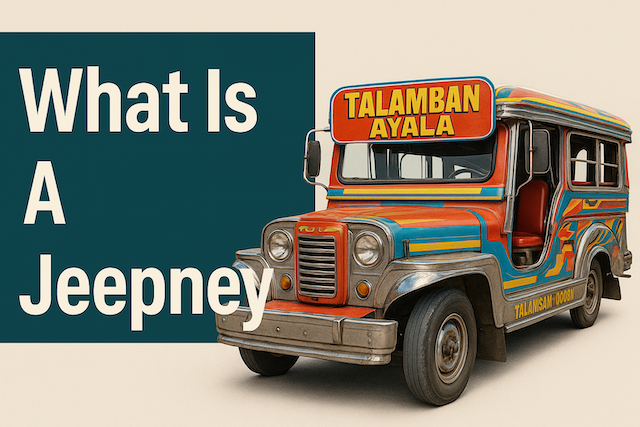What Is a Jeepney?A Deep Dive into the Philippines’ Most Iconic (and Confusing) Ride (2025 Edition)
Contents
- 1 🛺 What Is a Jeepney?A Deep Dive into the Philippines’ Most Iconic (and Confusing) Ride (2025 Edition)
- 1.1 📝 Introduction: A Ride That Defines the Philippines
- 1.2 2. 🚙 Origins of the Jeepney: From War Junk to Cultural Gem
- 1.3 3. 🧩 Anatomy of a Jeepney: What Makes It Unique?
- 1.4 4. 🛣️ How Jeepneys Operate: The Unwritten System
- 1.5 5. 📍 Jeepney Routes in Cebu: Key Examples for Travelers
- 1.6 6. 🧍♂️ Step-by-Step Guide: How to Ride a Jeepney as a Foreigner
- 1.7 7. 😅 Common Struggles for Foreigners (And Funny Stories)
- 1.8 8. ✅ Should You Ride One? Pros and Cons Breakdown
- 1.9 9. 🚨 Is It Safe? A Realistic Look at Jeepney Risks
- 1.10 10. 🏫 Why Language Schools Often Recommend Avoiding Jeepneys
- 1.11 11. ⚡ Modernization: The E-Jeepney Movement
- 1.12 12. 🇵🇭 Jeepney as a Cultural Symbol
- 1.13 13. 🎉 Bonus: 10 Things You Didn’t Know About Jeepneys
- 1.14 14. 🧳 Conclusion: Jeepney — Once in a Lifetime, or Every Day?
🛺 What Is a Jeepney?A Deep Dive into the Philippines’ Most Iconic (and Confusing) Ride (2025 Edition)
📝 Introduction: A Ride That Defines the Philippines
If you spend even a day in the Philippines — whether in the urban jungle of Manila or the laid-back energy of Cebu — you’ll quickly spot them: long, low, brightly decorated vehicles weaving through traffic, packed with passengers and bursting with personality.
These are Jeepneys — the undisputed king of Filipino public transport and one of the country’s most recognizable cultural symbols.
They’re loud. They’re colorful. They’re cheap.
And for many foreigners, they’re also completely baffling.
What is it? A bus? A jeep? A party on wheels?
How do you ride one? Where do they stop? How do you even pay?
More importantly — should you ride one?
In this article, we’ll break it all down for you.
From their wartime origins and eye-catching designs to their chaotic routes and fare-passing rituals, Jeepneys are more than just a way to get from point A to B — they’re a living, moving piece of Filipino culture.
But while they may be beloved by locals, they remain a mystery — and sometimes a safety concern — for many international travelers and students.
So whether you’re planning to explore Cebu, study English at a local academy, or just want to understand what that chrome-covered vehicle is doing with a “God Bless This Ride” sign on the back…
This is your ultimate guide to understanding the what, why, and how of Jeepneys in the Philippines.
2. 🚙 Origins of the Jeepney: From War Junk to Cultural Gem
To understand what a Jeepney is — and why it matters so much to Filipinos — you have to go back almost a century, to the aftermath of World War II.
🇺🇸 From American Jeeps to Filipino Streets
In 1945, as the war came to an end, the United States military left thousands of Willys jeeps scattered across the Philippine islands. These rugged, utilitarian vehicles had served as transportation for American soldiers, but once the war was over, they were simply abandoned.
Enter the Filipino spirit of resourcefulness and creativity.
Local mechanics and tinkerers began modifying these surplus jeeps to carry more people. They:
-
Extended the chassis to add two long bench seats in the back
-
Removed the rear cover for easier access
-
Added colorful decorations, lights, and religious icons
-
Eventually, began building new ones from scratch using local materials
The result? The very first Jeepneys — a mashup of “Jeep” and “Jitney,” an old American slang term for a shared taxi or small bus.
🏙️ From Necessity to National Identity
What started as a post-war transportation hack soon evolved into a nationwide phenomenon.
By the 1950s and 60s, Philippine-based manufacturers like Sarao Motors and Francisco Motors began producing Jeepneys at scale, supplying cities and towns with affordable, durable public transport.
Unlike mass-produced buses, each Jeepney became a canvas for its owner’s personality — painted with everything from Bible verses to basketball team logos to cartoon characters. They were loud, proud, and unapologetically Filipino.
Over the decades, Jeepneys went from being just transportation to a symbol of the Filipino identity — representing:
-
Ingenuity: turning military waste into a business
-
Community: promoting shared rides over private vehicles
-
Faith: with signs like “God Bless This Ride” or “In Jesus We Trust”
-
Freedom of expression: turning utility into art
📉 A Dying Breed?
But fast forward to today, and Jeepneys face an uncertain future.
The Philippine government is pushing for a transport modernization program aimed at replacing old Jeepneys with modern, electric versions. While the new units promise better safety and cleaner emissions, they lack the charm, affordability, and individuality of the traditional models.
For many Filipinos, the loss of the classic Jeepney feels like the loss of a cultural treasure.
3. 🧩 Anatomy of a Jeepney: What Makes It Unique?
At first glance, a Jeepney may look like an oversized toy car straight out of a street parade. But it’s not just the loud colors or chrome-heavy front that make it stand out — it’s the combination of function, flair, and Filipino flavor that defines the Jeepney’s anatomy.
Let’s take a closer look at what makes this vehicle so special, inside and out.
🖌️ Exterior: A Canvas on Wheels
No two Jeepneys are exactly alike — and that’s by design.
Owners often invest time, money, and heart into making their Jeepney stand out. It’s a source of pride, not just a job. The result? A traveling art exhibit powered by diesel.
Typical features include:
-
Chrome detailing: front bumpers, side mirrors, grills — shiny and exaggerated
-
Airbrushed murals: from religious icons like Jesus and Mary to Marvel superheroes or anime characters
-
Personal slogans: “Forever Young,” “God Is My Driver,” or even the owner’s name
-
Neon lights: making the Jeepney glow at night
-
Painted route information: the route is always printed in bold letters on the side or front windshield (e.g., “Lahug – Ayala – SM”)
Jeepneys aren’t just transport — they’re branding, belief, and bravado in motion.
🪑 Interior: A Lesson in Minimalism and Efficiency
Stepping inside a Jeepney is like stepping into a different world — one where every inch of space is used for maximum passenger density.
Interior layout:
-
Two long wooden or plastic benches line both sides of the vehicle
-
Passengers face inward, often sitting shoulder-to-shoulder
-
Maximum capacity? Technically 16–20. Realistically? As many as can physically fit
-
No air-conditioning, no seatbelts, and no personal space — just open windows and sweaty camaraderie
Common interior sights:
-
A mirror-covered dashboard with religious figurines
-
Plastic fans hanging from the ceiling (non-functioning 99% of the time)
-
A handwritten sign near the driver: “Exact fare only” or “No smoking”
-
A thin metal ceiling rod — used for tapping to signal a stop
👨🔧 The Driver’s Domain
Up front, the driver sits in a small cubicle-like space, surrounded by:
-
A tiny fare box
-
A display of rosaries and prayer cards
-
A laminated list of “Authorized Fares”
-
Sometimes a speaker system blasting karaoke or local FM radio
Most drivers own or rent their Jeepney and operate on a boundary system, meaning they must earn a minimum amount each day before making any personal income. It’s a tough life — and one they pursue with pride and grit.
🛠️ Built for the Long Haul (Sometimes Too Long)
Traditional Jeepneys are often held together by a mix of original WWII parts, recycled truck engines, and Filipino mechanical ingenuity.
Many have no odometer, no emissions control, and are maintained using sheer will and neighborhood workshops. It’s not unusual for a Jeepney to be over 30 years old and still running daily.
This longevity adds to their mythical status — but also explains why modernization is urgently needed.
Jeepneys are more than public transport — they are a mobile reflection of Filipino culture, family, faith, and hustle. Each one tells a story. Each one is built with hands, not factories. And each one is part vehicle, part soul.
4. 🛣️ How Jeepneys Operate: The Unwritten System
If you come from a country with structured public transport — subway lines, bus stops, route numbers, and real-time apps — you may find Jeepneys completely alien. While they do follow fixed routes, the rest of the system is largely improvised, unregulated, and unwritten.
Yet somehow, it works.
Let’s break down how Jeepneys operate in real life — from routes and stops to payment and etiquette.
🗺️ Routes: No Maps, No Apps, Just Paint
Each Jeepney follows a predefined route, usually connecting popular destinations: markets, malls, universities, and transport terminals. These routes are not displayed on Google Maps or official transit apps — instead, they are painted directly on the Jeepney itself.
Example routes in Cebu:
-
“Talamban – IT Park – Ayala – SM – Colon”
-
“Guadalupe – Capitol – Jones Avenue – Carbon Market”
-
“Mabolo – Lahug – JY Square – Ayala”
Veteran locals memorize these routes. Newcomers? Not so much.
Pro tip: If you’re unsure, ask someone nearby. Filipinos are famously friendly and often happy to help.
🛑 Stops: Wherever, Whenever
Jeepneys don’t use official bus stops. Instead:
-
To board: Stand by the road and wave your hand when you see the right Jeepney approaching.
-
To get off: Tap a coin or your ring against the metal bar above, or simply say “Lugar lang!” (“Just here, please”).
There’s no buzzer, bell, or stop light. The system relies on human communication and local norms.
This also means that Jeepneys stop frequently — anywhere, anytime — which can lead to traffic congestion or sudden halts.
💰 Fare System: Trust, Coins, and Relay Etiquette
Fares are incredibly affordable, typically between ₱13 to ₱20 (around $0.25 to $0.35 USD) depending on distance.
But there’s no conductor, no ticket, and no digital scanner.
Here’s how payment works:
-
Sit down and say your destination to a nearby passenger:
👉 “Bayad po, Ayala.” (“Fare please, to Ayala.”) -
Hand them your money (use coins or small bills).
-
They pass it forward — person by person — until it reaches the driver.
-
If change is needed, it travels back to you the same way.
Yes, this is normal. No, people rarely steal your money. It’s an example of Filipino trust and cooperation in action.
🤫 Silent Rules and Local Etiquette
There’s no signboard explaining how to behave, but locals follow a shared understanding:
-
Make yourself as small as possible — the goal is to fit more people, not stay comfortable.
-
Don’t block the entrance at the back — leave that spot open for boarding passengers.
-
Hold your bags in your lap or between your legs — not on the seat.
-
If someone says “Bayad po”, pass the fare forward. It’s your job.
-
Don’t expect personal space. Jeepneys are a communal experience.
🕐 Frequency and Timing: Organized Chaos
Jeepneys don’t run on a schedule. There are no apps to tell you when the next one is coming.
-
During peak hours, they’re everywhere.
-
Late at night or early morning? Good luck.
-
Rainy days? Expect delays or vehicle shortages.
-
Holidays? Some routes may stop entirely.
Locals rely on experience and gut feeling to estimate wait times. For foreigners, it’s a gamble — but one you might enjoy (once).
In a country where structure can be fluid and systems are often built on human relationships rather than hard infrastructure, the Jeepney is a perfect reflection. It’s not efficient by Western standards — but it’s functionally Filipino.
5. 📍 Jeepney Routes in Cebu: Key Examples for Travelers
Cebu, the second-largest metropolitan area in the Philippines, has one of the country’s most robust Jeepney networks. While that’s great for locals, it can be confusing for foreigners — especially since there are no official maps, apps, or route numbers.
But don’t worry. In this chapter, we’ll walk you through some of the most useful and popular Jeepney routes in Cebu that you’re likely to encounter as a student, traveler, or long-term visitor.
🧭 How to Read a Jeepney Route Sign
Before we dive into routes, here’s how to “read” a Jeepney:
-
Route signs are painted or posted on the front windshield, side panels, or above the driver’s head.
-
It typically lists key destinations in order (e.g., “Talamban – Ayala – SM – Colon”).
-
Some Jeepneys list neighborhoods or barangays, while others mention landmarks or malls.
-
If the sign is confusing, ask a local — most are happy to help.
🛣️ Route 1: Talamban – IT Park – Ayala – SM – Colon
Why it’s useful: This is one of the most common routes used by students and office workers.
-
Talamban: A residential and university area (University of San Carlos, North Campus)
-
IT Park: A modern business and nightlife hub
-
Ayala Mall: Major shopping and transit point
-
SM City Cebu: One of the biggest malls in Cebu
-
Colon Street: Oldest street in the Philippines, home to markets and budget shopping
➡️ Best for: Commuters going from suburbs to malls or downtown
🛣️ Route 2: Lahug – JY Square – Ayala
Why it’s useful: This route is great for those staying near language schools or dorms, especially in Lahug or near 3D ACADEMY.
-
Lahug: A quiet residential area with many affordable accommodations
-
JY Square: A small mall, food hub, and Jeepney terminal
-
Ayala: Again, a central point in almost all major Jeepney routes
➡️ Best for: Students going from dorms to shopping or transferring to other Jeepneys at Ayala Terminal
🛣️ Route 3: Guadalupe – Capitol – Fuente Circle – Colon
Why it’s useful: This route passes through the government and medical district, as well as Cebu’s historical core.
-
Guadalupe: A busy residential and church area
-
Capitol Site: Location of the Provincial Capitol and government offices
-
Fuente Osmeña Circle: Central roundabout, popular for hotels and nightlife
-
Colon Street: Traditional shopping and student area
➡️ Best for: Exploring old Cebu and doing errands near government offices
🛣️ Route 4: Mabolo – SM – Pier Area – Carbon Market
Why it’s useful: If you want to visit Cebu’s ports or experience the wet markets, this is your route.
-
Mabolo: Residential and semi-industrial area
-
SM City: Major mall stop
-
Pier 1–4: Where ferries to Bohol and other islands depart
-
Carbon Market: Cebu’s biggest wet market — chaotic but authentic
➡️ Best for: Adventurous travelers and island hoppers
💡 Pro Tips for Riding Cebu Jeepneys
-
Use landmarks, not addresses, when telling the driver your stop
-
Always carry coins or small bills (₱10s and ₱5s are ideal)
-
Some routes operate with numbered codes (e.g., “13C,” “04L”), but these are often unclear or used inconsistently — focus on destinations instead
-
Ayala and SM are key transfer points; nearly every route connects to at least one of them
-
Avoid rush hour (7–9 AM, 5–7 PM) unless you enjoy being squished like a sardine
With just a few key routes memorized and a bit of local help, navigating Cebu by Jeepney can actually be… fun. It’s messy, unpredictable, and at times uncomfortable — but it also offers a glimpse into how real life moves in the Philippines.
6. 🧍♂️ Step-by-Step Guide: How to Ride a Jeepney as a Foreigner
Riding a Jeepney for the first time can feel like jumping into a live-action video game: no instructions, no map, and no undo button. But don’t worry — with this step-by-step guide, you’ll look (almost) like a local on your very first try.
🪧 Step 1: Identify the Right Jeepney
Scan the painted signs on the front, sides, or windshield of the vehicle. Look for key destination names such as:
-
“Ayala – IT Park – Lahug”
-
“SM – Colon – Talamban”
-
“Carbon – Pier 1 – SM”
📌 Pro tip: Stand near known Jeepney stops like Ayala Terminal or JY Square to find more options. If in doubt, ask a local: “Does this go to Ayala?”
👋 Step 2: Flag It Down
There are no official stops, so once you see the right Jeepney coming:
-
Step toward the curb
-
Make eye contact with the driver
-
Extend your arm slightly and give a short wave
If there’s space, it’ll pull over. If not… the next one will.
🪜 Step 3: Climb In (Gracefully)
Board from the back. The entry is a low step with a narrow opening, so watch your footing.
-
Duck your head — the roof is low
-
Move all the way in so others can enter
-
Sit on either of the long benches (facing each other)
🛑 Don’t sit right at the back unless you’re getting off soon — it blocks new passengers.
💸 Step 4: Pay Your Fare
Once seated, prepare your payment — usually ₱13–₱20 depending on distance.
-
Say your destination to a nearby passenger:
👉 “Bayad po, Ayala.” (“Fare please, to Ayala.”) -
Hand them your money.
-
Your fare will be passed hand-to-hand to the driver. He will:
-
Confirm your drop-off point
-
Make change (if needed)
-
Send it back the same way
-
🎓 Don’t forget to say “Salamat” (Thank you) when your change returns!
🔔 Step 5: Signal When You Want to Get Off
There’s no bell or button. To stop:
-
Tap a coin or ring against the metal ceiling rod
-
Or say: “Lugar lang!” (loo-GAHR lang) — literally “Just here!”
The driver will pull over — often suddenly — so hold on tight.
📍 Pro tip: Use Google Maps in real time to know where you are and when to get off. Watch your blue dot!
🧳 Bonus Tips for First-Timers
-
✅ Sit near the middle if you’re not sure where to get off — it’s less awkward
-
❌ Never flash your phone or wallet near open areas
-
🎧 No headphones — stay alert
-
😓 Prepare for heat — wear breathable clothes
-
💬 Practice these phrases:
-
“Bayad po.” (Here’s my fare)
-
“Lugar lang.” (Stop here)
-
“Sa Ayala ko.” (I’m going to Ayala)
-
It might feel intimidating at first, but many foreigners remember their first Jeepney ride as a defining part of their Philippines experience. Think of it as a rite of passage — a test of street smarts, adaptability, and cultural curiosity.
Ride once, and you’ll never forget it. Ride twice, and you might even enjoy it.
7. 😅 Common Struggles for Foreigners (And Funny Stories)
Let’s be honest: riding a Jeepney as a foreigner for the first time is rarely smooth. Between unfamiliar etiquette, unclear routes, and language barriers, it’s easy to feel lost — or even mildly panicked.
But that’s also part of the adventure.
In this chapter, we’ll cover some of the most common struggles international students and travelers face when taking Jeepneys — and share a few stories that might make you laugh, or at least help you feel less alone.
🌀 Struggle 1: “Wait, where is this going?”
The problem: Jeepney routes are not shown on apps or printed anywhere clearly.
The result: Many foreigners end up completely lost.
🗣️ Anna from Germany shares:
“I got on a Jeepney that said ‘IT Park – Ayala – Colon.’ I thought it was going to IT Park… but it was coming from there. I ended up in a market I couldn’t pronounce.”
Tip: Always clarify with the driver or another passenger before boarding. Ask:
👉 “IT Park, going to Ayala?” to be sure.
🎯 Struggle 2: Getting the Fare Wrong
Some foreigners:
-
Forget to pay
-
Try to hand cash directly to the driver (difficult if you’re in the back)
-
Don’t have small bills
🗣️ Mateo from Argentina says:
“I only had a ₱1,000 note and the driver laughed. He said, ‘ATM na lang!’”
💡 Lesson: Always carry coins or small bills — ₱20 and below. Don’t rely on receiving change for large amounts, especially during rush hour.
🔇 Struggle 3: Not Knowing What to Say
If you don’t speak Cebuano or Tagalog, even the simplest things — like asking to stop — can be stressful.
🗣️ Chloe from South Korea:
“I wanted to say ‘Lugar lang’ but I panicked and just yelled ‘Stop!’ The driver didn’t hear me, and I ended up two stops too far.”
💬 Pro tip: Practice this phrase before riding:
👉 “Lugar lang po” = “Just here, please.”
Say it loudly and clearly — Jeepneys are noisy!
🥵 Struggle 4: Physical Discomfort
Let’s be honest — Jeepneys aren’t made for tall or large bodies. They’re tight, hot, and sometimes smelly.
🗣️ Thomas from Canada says:
“I’m 6’2″. I had to fold myself into a human pretzel. It was an impressive yoga session.”
Jeepneys often don’t have fans, and there’s no air-conditioning. You’ll sweat. A lot.
💡 Dress light, bring water, and avoid riding during noon hours unless absolutely necessary.
🎒 Struggle 5: Keeping Your Belongings Safe
Jeepneys are open at the back, and you may find yourself next to strangers in close quarters. That’s not ideal for tourists carrying phones, wallets, or cameras.
🗣️ Emily from Australia:
“I took a video for Instagram and five seconds later someone shouted ‘Hide your phone!’”
💡 Keep all belongings in front of you. Don’t use your phone near open windows. If you need to use GPS, do it discreetly.
😂 Bonus: “Jeepney First-Timer Bingo”
✅ Sat on the edge and blocked new passengers
✅ Said “Lugar lang” too early
✅ Paid with a ₱100 and got the look
✅ Rode the wrong way
✅ Smiled awkwardly the whole time
If you check off 3 or more… welcome to the club. You’ve earned your stripes.
Yes, Jeepney rides can be messy, confusing, and a bit sweaty. But they’re also part of the true Filipino experience — and great for stories you’ll be telling for years.
8. ✅ Should You Ride One? Pros and Cons Breakdown
Before you hop on a Jeepney (or decide to avoid it altogether), let’s lay out the pros and cons clearly:
| Factor | Pros | Cons |
|---|---|---|
| 💸 Cost | Incredibly cheap (₱13–₱20) | No change for large bills |
| 🧭 Availability | Ubiquitous — Jeepneys are everywhere | Routes are hard to understand |
| 🌏 Cultural Value | Authentic Filipino experience | Can be overwhelming for first-timers |
| 🛠️ Simplicity | No app or ticket needed | No schedule, no structure |
| 🧍♀️ Social Exposure | Meet locals and see daily life | Crowded, no personal space |
| 🧳 Luggage | Hands-free riding for commuters | Not suitable for big bags or gear |
Summary: If you’re adventurous and don’t mind a little chaos, it’s worth trying once. But for daily transport, especially if you’re new to Cebu, consider safer options like Grab or school shuttles.
9. 🚨 Is It Safe? A Realistic Look at Jeepney Risks
Let’s not sugarcoat it — Jeepneys have safety risks, especially for foreigners unfamiliar with the system.
Common Concerns:
-
Pickpocketing: Happens mostly in crowded areas or when you’re distracted
-
Snatch-and-run theft: Items near the rear opening are easy targets for thieves on motorcycles
-
Sudden stops: No seatbelts, no warnings — hold on tight
-
Night travel: Avoid Jeepneys late at night, especially in quiet or poorly lit areas
-
Old vehicles: Many Jeepneys are decades old and not always roadworthy
Smart Safety Tips:
-
Sit far from the back if possible
-
Keep bags in front of you at all times
-
Don’t use your phone openly
-
Trust your instincts — if something feels wrong, don’t get on
Bottom line: While Jeepneys are safe most of the time, they’re not the safest choice. If you’re carrying valuables or unfamiliar with your destination, opt for Grab or a taxi.
10. 🏫 Why Language Schools Often Recommend Avoiding Jeepneys
Many English schools in Cebu — including 3D ACADEMY — advise students not to use Jeepneys, especially when they first arrive. Here’s why:
🎓 Top Reasons:
-
Safety: New students are easy targets for petty crime
-
Time management: Jeepney travel is unpredictable and can cause delays
-
Communication issues: Misunderstandings can lead to getting lost
-
Fatigue: Riding in crowded, hot vehicles can be physically draining — not ideal before class
-
Insurance limitations: Some student insurance plans don’t cover Jeepney-related incidents
Instead, most schools recommend:
-
Grab (ride-hailing app)
-
School shuttle services
-
Walking to nearby spots (like JY Square from 3D)
That doesn’t mean Jeepneys are “bad” — just that they’re not beginner-friendly. Once you’re more comfortable with Cebu, you can explore more freely.
11. ⚡ Modernization: The E-Jeepney Movement
The Philippines is in the middle of a massive shift in public transportation — and Jeepneys are at the center of it.
🔋 What Are E-Jeepneys?
Modernized Jeepneys are:
-
Electric or low-emission diesel
-
Air-conditioned
-
Equipped with digital fare systems
-
GPS-enabled
-
More spacious and standardized
They look more like minibuses than traditional Jeepneys — but retain the shared seating model.
📉 Resistance and Transition
The government’s Public Utility Vehicle Modernization Program (PUVMP) aims to phase out old Jeepneys entirely. But it’s controversial:
-
Drivers can’t afford new units (often costing over ₱2 million)
-
Protests and transport strikes have slowed implementation
-
Some fear the loss of cultural heritage and jobs
Still, electric Jeepneys are growing in number — especially in Metro Manila and larger cities. Cebu is slowly adopting them too.
Within 5–10 years, the classic Jeepney may become a rare sight — or even a museum piece.
12. 🇵🇭 Jeepney as a Cultural Symbol
Beyond transportation, Jeepneys represent the Filipino spirit — adaptive, creative, colorful, and community-centered.
What It Represents:
-
Community: Dozens of people sharing a small space peacefully
-
Faith: Crosses, saints, and Bible verses remind passengers of shared beliefs
-
Pride: Each vehicle is hand-decorated, often by the owners themselves
-
Identity: The Jeepney is to the Philippines what the yellow cab is to New York — a moving cultural icon
Jeepneys appear in:
-
Filipino movies and music videos
-
Tourism ads
-
National celebrations
-
Souvenirs and pop art
Even as modernization looms, many Filipinos hope to preserve the essence of the Jeepney — if not the vehicle itself, then its symbolic value.
13. 🎉 Bonus: 10 Things You Didn’t Know About Jeepneys
-
🚙 The name “Jeepney” combines “Jeep” and “Jitney” (a slang word for shared taxi)
-
🎨 No two Jeepneys are the same — each one is uniquely decorated
-
⏱️ Some Jeepneys are over 30 years old and still in operation
-
💡 Early Jeepneys were literally made from WWII scrap metal
-
🚦 Jeepneys don’t follow stoplights strictly — especially on side roads
-
🗺️ The longest route in Cebu can take over 2 hours from end to end
-
🏆 Jeepney decorating competitions exist during town fiestas
-
🎶 Some Jeepneys have karaoke machines on board
-
💼 Drivers rent their units and must earn a “boundary” before making money
-
🧼 Some Jeepneys carry signs that say “Thank you for paying the exact fare!” even though they rarely enforce it
14. 🧳 Conclusion: Jeepney — Once in a Lifetime, or Every Day?
Jeepneys are loud. They’re confusing. They’re sweaty and sometimes chaotic.
But they’re also friendly, charming, and deeply Filipino.
If you’re staying in the Philippines for a while — especially in Cebu — we recommend this:
✅ Try riding a Jeepney once
✅ Choose a short, simple route (like JY Square to Ayala)
✅ Go during daylight hours
✅ Keep your expectations low and your curiosity high
Because in the end, the Jeepney is more than just a vehicle — it’s a window into the daily life, history, and heart of the Philippines.
You may not ride it every day. But ride it once — and you’ll never forget it.
🛺 Ready to explore more about Filipino culture and study abroad life in Cebu?
Check out our full guides on living in Cebu, transportation tips, and studying English at 3D ACADEMY.







